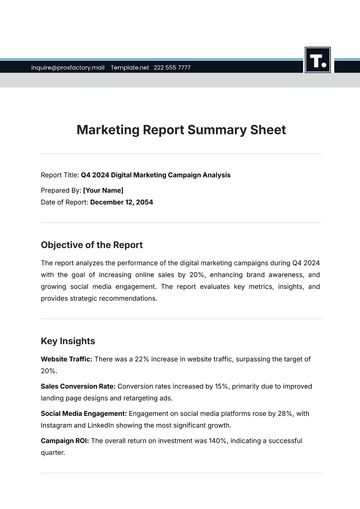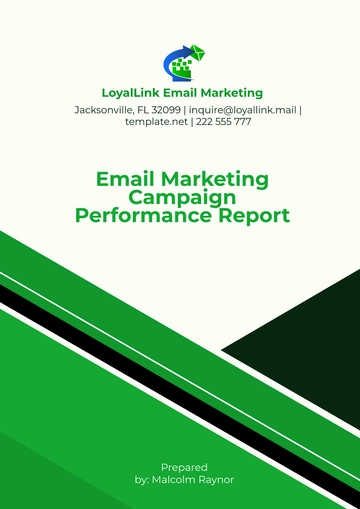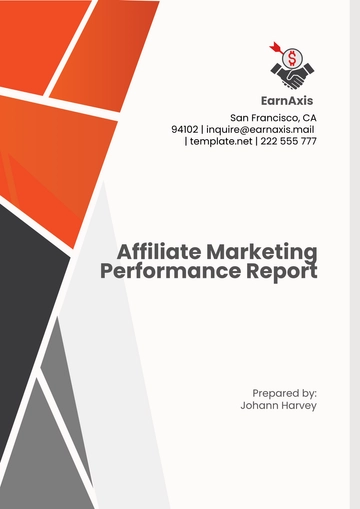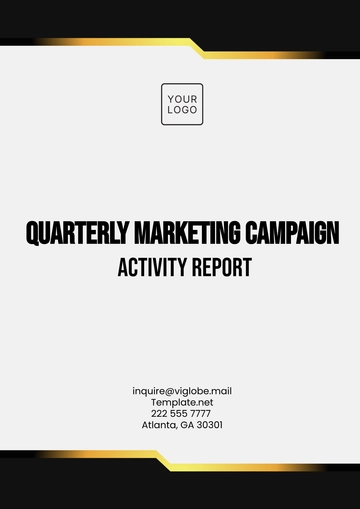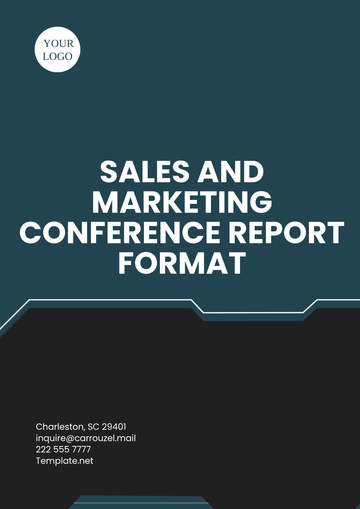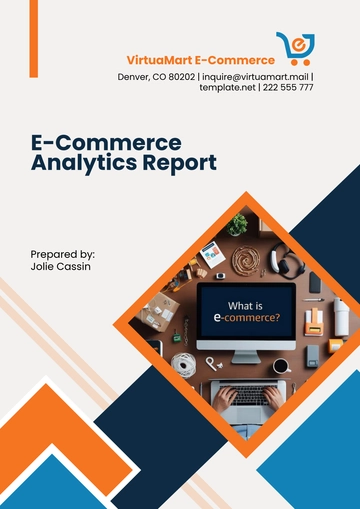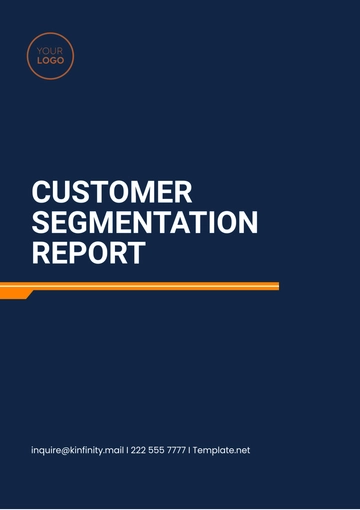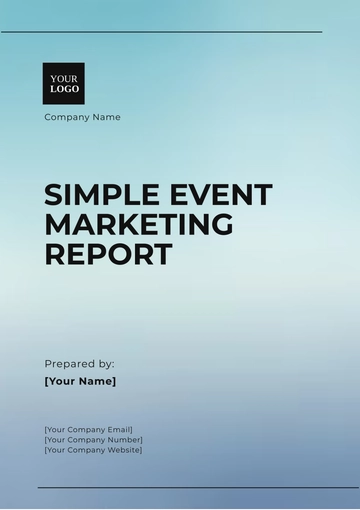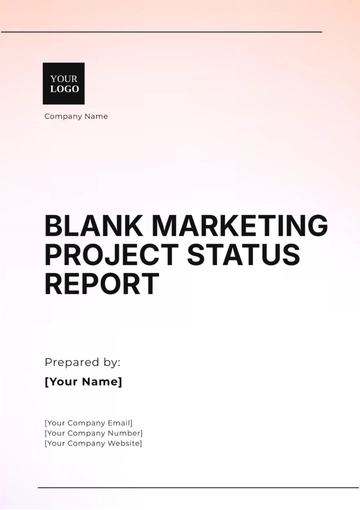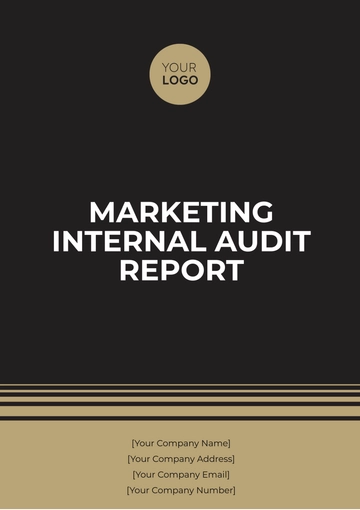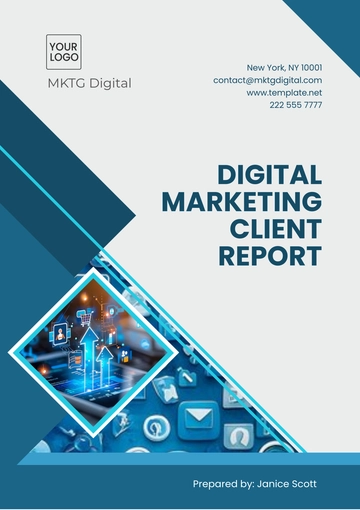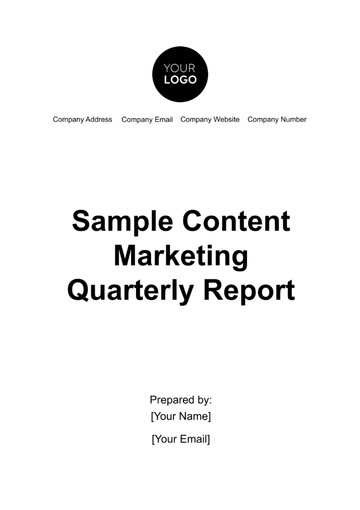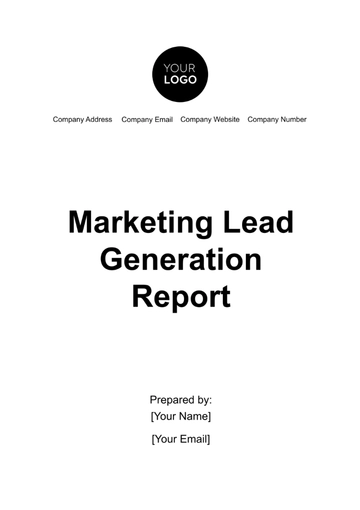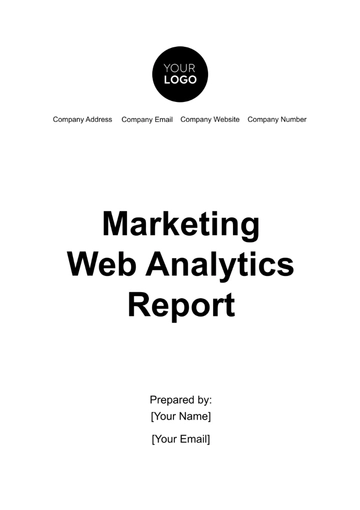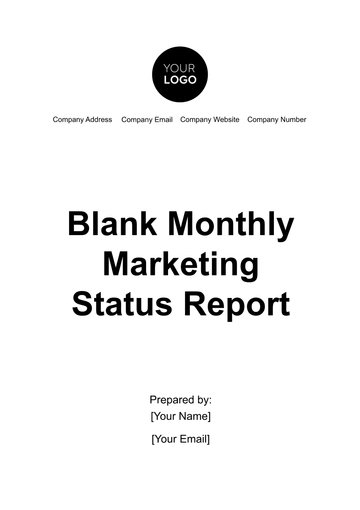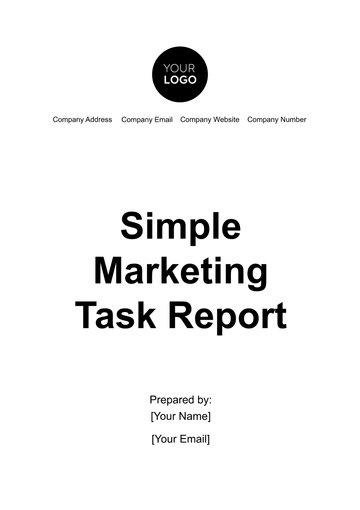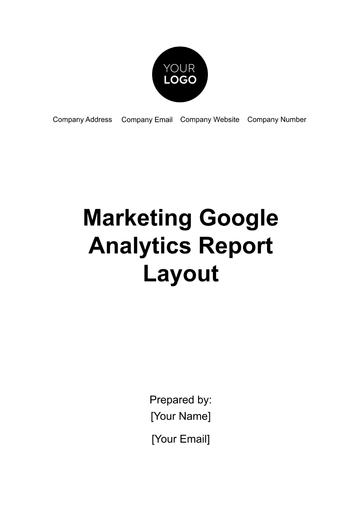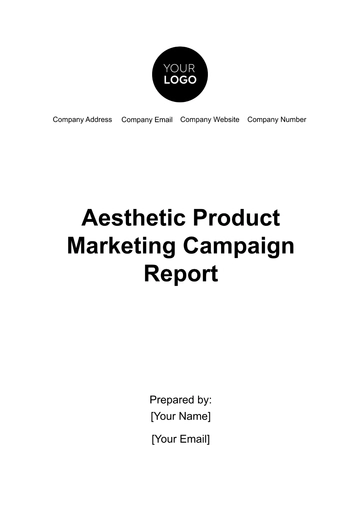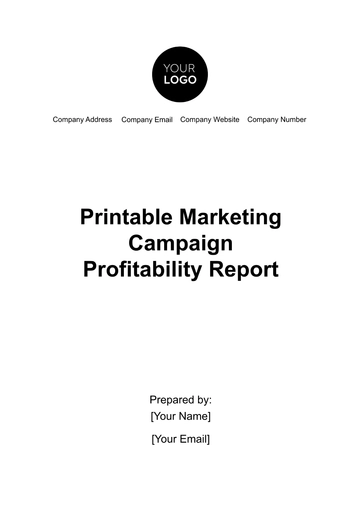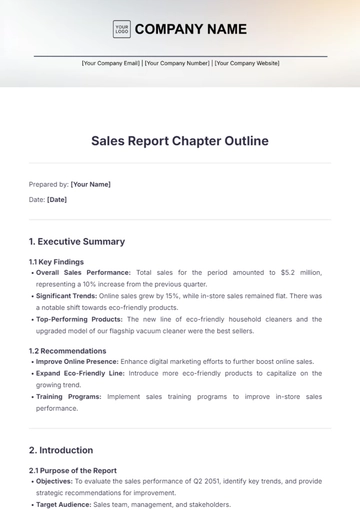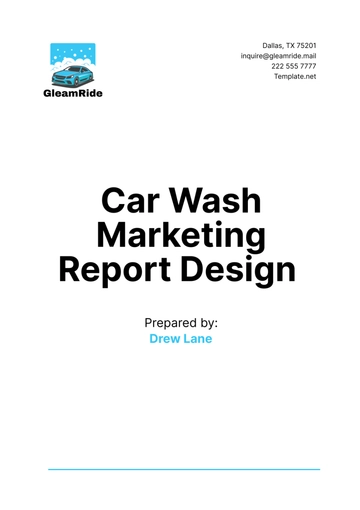Free Cafe Marketing Report
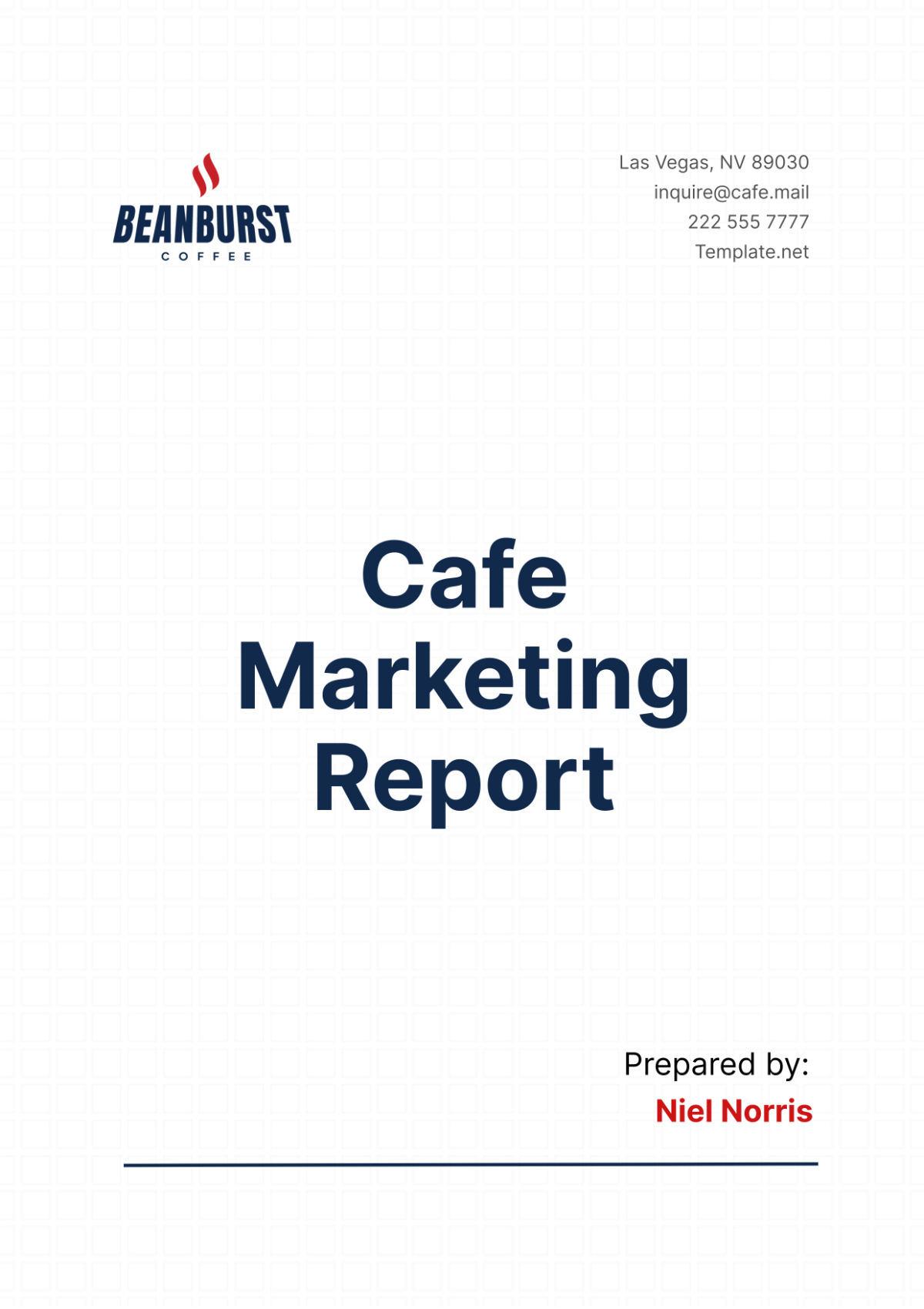
Date: January 1, 2050
I. Executive Summary
This marketing report provides a comprehensive analysis of the current marketing strategies, competitive landscape, and potential growth opportunities for [Your Company Name] Cafe. The report spans the last quarter of 2049, offering insights into our marketing performance, market position, and strategic recommendations for future growth. Our primary goals include increasing customer engagement, expanding market share, and solidifying our brand presence in the community.
II. Objectives
1. Short-Term Objectives
Increase Customer Foot Traffic: Our goal is to increase customer foot traffic by 10% within the next quarter. To achieve this, we will employ a multi-faceted approach that includes both digital and offline marketing efforts.
Digital Marketing: We will utilize social media platforms such as Facebook, Instagram, and Twitter to launch targeted advertising campaigns. These campaigns will focus on promoting special offers, new menu items, and events to attract more customers to the cafe.
Email Campaigns: Sending out regular newsletters with exclusive promotions and updates about upcoming events will keep our current customers engaged and encourage them to visit more frequently.
Local SEO: Improving our online visibility through local SEO practices will help attract new customers who are searching for cafes in our area.
Offline Marketing: Distributing flyers and posters in nearby offices, universities, and community centers will raise awareness about our cafe. Additionally, we will collaborate with local businesses to cross-promote our offerings.
Boost Social Media Engagement: Enhancing social media engagement by 25% by the end of Q1 2050 is another key objective. This will be achieved through a combination of targeted campaigns and interactive content.
Interactive Content: Creating engaging content such as polls, contests, and Q&A sessions will encourage our followers to interact with our posts. For example, a photo contest where customers share their favorite moments at our cafe can generate excitement and increase engagement.
User-Generated Content: Encouraging customers to share their experiences and tag us in their posts will help build a sense of community and increase our online presence.
Influencer Collaborations: Partnering with local influencers to promote our cafe will expand our reach and attract new followers. Influencers can share their experiences and reviews, which can significantly boost our credibility and engagement.
Consistent Posting Schedule: Maintaining a consistent posting schedule with high-quality visuals and engaging captions will keep our audience interested and engaged.
2. Long-Term Objectives
Achieve Market Share: We aim to achieve a market share of 15% within two years by expanding our customer base and increasing brand loyalty.
Brand Loyalty Programs: Implementing a robust loyalty program that rewards frequent customers with discounts, free items, and exclusive offers will encourage repeat visits and foster brand loyalty.
Market Penetration Strategies: Aggressive marketing campaigns that highlight our unique selling points, such as premium coffee blends and excellent customer service, will help us attract new customers and increase our market share.
Customer Retention Initiatives: Regularly collecting and acting on customer feedback will help us improve our offerings and retain our customers. Personalized marketing efforts, such as birthday discounts and personalized recommendations, will enhance the customer experience.
Expand Locations: Planning to expand to two new locations by 2052 will help us capitalize on growing demand and market opportunities.
Market Research: Conducting thorough market research to identify potential locations with high demand for specialty coffee and limited competition will be crucial for successful expansion.
Financial Planning: Developing a detailed financial plan that includes budgeting, funding options, and projected revenue will ensure that we are financially prepared for expansion.
Strategic Partnerships: Forming strategic partnerships with local businesses and suppliers will help us establish a strong presence in new markets.
Operational Efficiency: Ensuring that our current operations are efficient and scalable will be essential for managing multiple locations successfully.
III. Target Audience
Identifying and understanding our target audience is crucial for crafting effective marketing strategies. Our primary target audience includes young professionals, local residents, and social media influencers who are passionate about cafe culture and high-quality coffee.
Audience Segmentation
1. Young Professionals (Aged 25-35):
Demographics: Ages 25-35, working professionals, urban dwellers.
Preferences: Young professionals seek premium coffee, quick service, and a conducive environment for work and social meetings. They value convenience and quality.
Marketing Strategy:
Targeted Social Media Ads: Using data analytics to target social media ads specifically at young professionals based on their interests and online behaviors.
Partnerships with Local Businesses: Collaborating with local businesses to offer special promotions and discounts to their employees.
Loyalty Programs: Implementing loyalty programs that offer rewards for frequent visits, making it more attractive for young professionals to choose our cafe for their daily coffee needs.
2. Local Residents (Within a 5-Mile Radius):
Demographics: Ages 30-60, families, community members.
Preferences: Local residents prefer a comfortable ambiance, community events, and a family-friendly environment. They value a cafe that feels like a community hub.
Marketing Strategy:
Local Advertising: Placing ads in local newspapers, community bulletins, and on local radio stations to reach residents within the area.
Community Sponsorships: Sponsoring local events such as farmers markets, school functions, and community fairs to increase visibility and show support for the community.
Family-Oriented Events: Hosting family-oriented events such as weekend brunches, children’s story hours, and holiday celebrations to attract local families.
3. Social Media Influencers and Bloggers:
Demographics: Ages 20-40, active social media users, content creators.
Preferences: Influencers and bloggers look for unique experiences, aesthetically pleasing environments, and exclusive content opportunities. They value places that offer Instagrammable moments and unique stories to share.
Marketing Strategy:
Collaborate on Social Media Campaigns: Partnering with influencers to create and share content about our cafe, such as behind-the-scenes looks, exclusive menu tastings, and event promotions.
Provide Exclusive Offers: Offering special deals and invites to influencers for exclusive events or menu previews to create buzz and attract their followers.
Host Influencer Events: Organizing events specifically for influencers and bloggers to experience and share our cafe’s offerings with their audience, thus amplifying our reach.
By tailoring our marketing strategies to these specific audience segments, [Your Company Name] Cafe can effectively reach and engage with its target customers, driving both short-term and long-term growth.
IV. Market Analysis
1. Competitor Analysis
Understanding our competitive landscape helps us position [Your Company Name] Cafe effectively and identify areas for improvement. Analyzing the strengths and weaknesses of our competitors provides valuable insights into how we can differentiate ourselves and better meet the needs of our target audience.
Competitor Breakdown:
Competitor | Strengths | Weaknesses |
|---|---|---|
Cafe A | Strong brand recognition, diverse menu | Higher prices, limited seating |
Cafe B | Prime location, local partnerships | Inconsistent service quality |
Cafe C | Unique specialty coffees, great ambiance | Higher operational costs, niche market |
Detailed Analysis:
Cafe A:
Strengths: Cafe A has established strong brand recognition and offers a diverse menu that appeals to a wide range of customers. Their brand loyalty is a significant asset, and they are known for their consistent quality.
Weaknesses: Despite their popularity, Cafe A's higher prices can deter price-sensitive customers. Additionally, their limited seating capacity often results in long wait times, which can negatively impact the customer experience.
Cafe B:
Strengths: Cafe B benefits from a prime location with high foot traffic and strong local partnerships that enhance their visibility and community presence. They are well-positioned to attract customers from nearby businesses and residential areas.
Weaknesses: However, Cafe B struggles with inconsistent service quality, which can lead to customer dissatisfaction. Their reliance on local partnerships also means that any disruption in these relationships could impact their business.
Cafe C:
Strengths: Cafe C is renowned for its unique specialty coffees and great ambiance, making it a popular choice for coffee enthusiasts and those seeking a unique cafe experience. Their focus on specialty coffee differentiates them from more generic competitors.
Weaknesses: The niche market and higher operational costs of Cafe C can limit their customer base to a specific demographic. Additionally, their pricing may not appeal to a broader audience, and they face challenges in scaling their operations due to these costs.
2. SWOT Analysis
Conducting a SWOT analysis provides a clear picture of our internal capabilities and external opportunities and threats. This strategic planning tool helps us identify the factors that can impact our success and formulate strategies to leverage our strengths and opportunities while addressing our weaknesses and mitigating threats.
Strengths:
Unique Coffee Blends: Our cafe offers a range of unique coffee blends that differentiate us from competitors and attract coffee enthusiasts.
Excellent Customer Service: Our commitment to providing excellent customer service helps build strong customer relationships and loyalty.
Weaknesses:
Limited Marketing Budget: Our current marketing budget is limited, which can restrict our ability to execute large-scale marketing campaigns and reach a broader audience.
Small Physical Space: The small physical space of our cafe can limit the number of customers we can serve at peak times and restrict our ability to host large events.
Opportunities:
Emerging Market for Specialty Coffees: The growing interest in specialty coffee and unique brewing methods presents a significant opportunity for [Your Company Name] Cafe to attract a niche market of coffee enthusiasts.
Increased Remote Work Culture: The increase in remote work has driven demand for cafes that provide a conducive environment for working and meeting, which we can capitalize on by offering amenities like free Wi-Fi and comfortable seating.
Threats:
Rising Competition: The increasing number of cafes in our area intensifies competition, making it crucial to continuously innovate and differentiate our offerings.
Fluctuating Coffee Bean Prices: The fluctuating prices of coffee beans can impact our cost structure and profit margins, requiring careful financial management and pricing strategies.
Market Trends
Understanding current market trends is essential for aligning our strategies with customer expectations and industry developments. Here are two significant trends that influence our market:
1. Specialty Coffees: The growing interest in specialty coffee and unique brewing methods presents a significant opportunity for [Your Company Name] Cafe. Consumers are becoming more knowledgeable about coffee origins, brewing techniques, and flavor profiles, leading to increased demand for high-quality, specialty coffee. This trend aligns well with our focus on unique coffee blends and provides an opportunity to attract a discerning customer base.
Strategies to Leverage This Trend:
Expand Specialty Offerings: Introduce new and exclusive coffee blends that cater to the evolving tastes of coffee enthusiasts.
Educational Content: Offer coffee brewing workshops and tastings to educate customers about specialty coffee, enhancing their appreciation and loyalty.
Highlight Quality: Emphasize the quality and uniqueness of our coffee in marketing materials and in-cafe signage to attract specialty coffee consumers.
2. Remote Work Culture: The increase in remote work has driven demand for cafes that provide a conducive environment for working and meeting. Many professionals are now seeking out cafes that offer reliable Wi-Fi, comfortable seating, and a quiet atmosphere where they can work productively.
Strategies to Leverage This Trend:
Create a Work-Friendly Environment: Ensure our cafe is equipped with comfortable seating, power outlets, and strong Wi-Fi to cater to remote workers.
Promote Work Spaces: Market our cafe as an ideal spot for remote work through social media and local advertising, highlighting the amenities we offer.
Host Networking Events: Organize networking events and coworking days to attract professionals who are looking for a community of like-minded individuals.
By understanding our competitors, analyzing our strengths and weaknesses, and aligning our strategies with market trends, [Your Company Name] Cafe can effectively position itself in the market, attract and retain customers, and achieve sustained growth. This comprehensive market analysis serves as a foundation for informed decision-making and strategic planning, helping us navigate the competitive landscape and capitalize on emerging opportunities.
V. Marketing Strategies
1. Digital Marketing
Leveraging digital marketing strategies is essential for reaching a broader audience and increasing brand awareness.
1. Social Media Marketing:
Platforms: Focus on Facebook, Instagram, and Twitter.
Content: Share high-quality images, videos, customer testimonials, and behind-the-scenes content.
Campaigns: Run targeted ads and promotions to increase engagement and attract new followers.
Engagement: Use interactive content such as polls, contests, and Q&A sessions to boost engagement.
2. Email Marketing:
Newsletters: Send monthly newsletters with updates on new products, upcoming events, and special offers.
Segmentation: Tailor email content to different customer segments based on their preferences and purchase history.
3. SEO and Website Optimization:
Content: Regularly update the blog with articles on coffee culture, brewing tips, and cafe news.
Keywords: Optimize website content with relevant keywords to improve search engine rankings.
User Experience: Ensure the website is mobile-friendly and easy to navigate.
2. In-Store Promotions
Enhancing the in-store experience is key to building customer loyalty and encouraging repeat visits.
1. Loyalty Programs:
Rewards: Offer points for every purchase that can be redeemed for discounts or free items.
Tiers: Create tiered membership levels with increasing benefits.
2. Live Events and Workshops:
Events: Host live music nights, coffee tastings, and art exhibitions to attract diverse customer groups.
Workshops: Conduct coffee brewing and latte art workshops to engage customers and enhance their experience.
3. Seasonal Promotions:
Limited-Time Offers: Introduce seasonal beverages and snacks to keep the menu fresh and exciting.
Holiday Campaigns: Run special promotions during holidays to boost sales and attract new customers.
VI. Budget Allocation
Effective budget allocation ensures that our marketing efforts are both impactful and sustainable.
Budget Breakdown for Q1 2050
Category | Amount | Percentage of Total Budget |
|---|---|---|
Digital Marketing | $20,000 | 40% |
In-Store Promotions | $15,000 | 30% |
Events and Partnerships | $10,000 | 20% |
Contingency Fund | $5,000 | 10% |
Total | $50,000 | 100% |
Detailed Allocation
1. Digital Marketing ($20,000):
Social Media Ads: $8,000
Email Marketing: $4,000
SEO and Website Optimization: $5,000
Content Creation: $3,000
2. In-Store Promotions ($15,000):
Loyalty Program Implementation: $7,000
Live Events and Workshops: $5,000
Seasonal Promotions: $3,000
3. Events and Partnerships ($10,000):
Community Sponsorships: $4,000
Collaborative Events: $3,000
Influencer Collaborations: $3,000
4. Contingency Fund ($5,000):
Reserved for unexpected expenses and additional promotional opportunities.
VII. Performance Metrics
Tracking key performance indicators (KPIs) helps us measure the effectiveness of our marketing strategies and make data-driven decisions.
Key Performance Indicators (KPIs)
1. Customer Foot Traffic:
Measurement: Use in-store counters and sales data to track the number of visitors.
Goal: Increase foot traffic by 10% within the next quarter.
2. Social Media Engagement:
Measurement: Monitor likes, comments, shares, and follower growth on social media platforms.
Goal: Boost engagement by 25% by the end of Q1 2050.
3. Monthly Sales Revenue:
Measurement: Track daily and monthly sales figures to assess revenue growth.
Goal: Achieve a 15% increase in monthly sales revenue.
4. Customer Satisfaction Scores:
Measurement: Collect feedback through surveys, online reviews, and in-cafe comment cards.
Goal: Maintain an average customer satisfaction score of 4.5 out of 5.
Data Collection and Analysis
1. Surveys and Feedback:
Conduct regular customer surveys to gather insights on their preferences and experiences.
Use feedback to identify areas for improvement and adjust marketing strategies accordingly.
2. Analytics Tools:
Utilize analytics tools to track website traffic, social media engagement, and email campaign performance.
Analyze data to identify trends, measure ROI, and optimize future campaigns.
3. Sales Data:
Regularly review sales data to monitor the effectiveness of in-store promotions and events.
Adjust marketing efforts based on sales performance and customer behavior.
VIII. Conclusion
Summary
In conclusion, [Your Company Name] Cafe has significant growth potential in the café market, particularly by leveraging digital marketing and community engagement strategies. By understanding our target audience, analyzing the competitive landscape, and implementing effective marketing strategies, we can achieve our short-term and long-term objectives.
Future Outlook
Moving forward, our focus will be on enhancing customer engagement, increasing brand awareness, and driving revenue growth. By continuously monitoring performance metrics and adapting our strategies, we can ensure sustained success and expansion for [Your Company Name] Cafe.
Call to Action
We encourage the marketing team to diligently follow this report's recommendations, regularly assess performance metrics, and remain adaptable to changes in market trends and customer preferences. With a committed and strategic approach, we are confident that [Your Company Name] Cafe will continue to thrive and become a beloved community hub.
Prepared by:
[Your Name]
[Your Position]
[Your Company Name] Cafe
[Your Company Address]
[Your Company Number]
[Your Company Email]
[Your Company Website]
- 100% Customizable, free editor
- Access 1 Million+ Templates, photo’s & graphics
- Download or share as a template
- Click and replace photos, graphics, text, backgrounds
- Resize, crop, AI write & more
- Access advanced editor
Craft compelling marketing reports for your cafe effortlessly with Template.net's Cafe Marketing Report Template. Utilizing our AI editor tool, customize and enhance your reports with ease. This template offers a structured format for analyzing marketing strategies, tracking campaign performance, and presenting key insights to stakeholders. Elevate your cafe's marketing efforts and drive growth with this comprehensive reporting solution from Template.net.
You may also like
- Sales Report
- Daily Report
- Project Report
- Business Report
- Weekly Report
- Incident Report
- Annual Report
- Report Layout
- Report Design
- Progress Report
- Marketing Report
- Company Report
- Monthly Report
- Audit Report
- Status Report
- School Report
- Reports Hr
- Management Report
- Project Status Report
- Handover Report
- Health And Safety Report
- Restaurant Report
- Construction Report
- Research Report
- Evaluation Report
- Investigation Report
- Employee Report
- Advertising Report
- Weekly Status Report
- Project Management Report
- Finance Report
- Service Report
- Technical Report
- Meeting Report
- Quarterly Report
- Inspection Report
- Medical Report
- Test Report
- Summary Report
- Inventory Report
- Valuation Report
- Operations Report
- Payroll Report
- Training Report
- Job Report
- Case Report
- Performance Report
- Board Report
- Internal Audit Report
- Student Report
- Monthly Management Report
- Small Business Report
- Accident Report
- Call Center Report
- Activity Report
- IT and Software Report
- Internship Report
- Visit Report
- Product Report
- Book Report
- Property Report
- Recruitment Report
- University Report
- Event Report
- SEO Report
- Conference Report
- Narrative Report
- Nursing Home Report
- Preschool Report
- Call Report
- Customer Report
- Employee Incident Report
- Accomplishment Report
- Social Media Report
- Work From Home Report
- Security Report
- Damage Report
- Quality Report
- Internal Report
- Nurse Report
- Real Estate Report
- Hotel Report
- Equipment Report
- Credit Report
- Field Report
- Non Profit Report
- Maintenance Report
- News Report
- Survey Report
- Executive Report
- Law Firm Report
- Advertising Agency Report
- Interior Design Report
- Travel Agency Report
- Stock Report
- Salon Report
- Bug Report
- Workplace Report
- Action Report
- Investor Report
- Cleaning Services Report
- Consulting Report
- Freelancer Report
- Site Visit Report
- Trip Report
- Classroom Observation Report
- Vehicle Report
- Final Report
- Software Report
